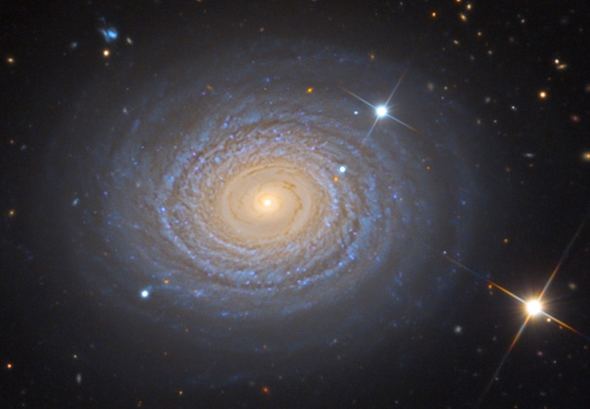bystander wrote: ↑Mon Nov 16, 2020 4:41 pm Cosmic Cinnamon Bun
ESA Hubble Picture of the Week | 2020 Nov 16Observed with the NASA/ESA Hubble Space Telescope, the faint galaxy featured in this image is known as UGC 12588. Unlike many spiral galaxies, UGC 12588 displays neither a bar of stars across its centre nor the classic prominent spiral arm pattern. Instead, to a viewer, its circular, white and mostly unstructured centre makes this galaxy more reminiscent of a cinnamon bun than a mega-structure of stars and gas in space.
Lying in the constellation of Andromeda in the Northern hemisphere, this galaxy is classified as a spiral galaxy. Unlike the classic image of a spiral galaxy, however, the huge arms of stars and gas in UGC 12588 are very faint, undistinguished, and tightly wound around its centre. The clearest view of the spiral arms comes from the bluer stars sprinkled around the edges of the galaxy that highlight the regions where new star formation is most likely taking place.
Found Images: 2020 November
Re: HEIC: Cosmic Cinnamon Bun (UGC 12588)
Color Commentator
-
starsurfer
- Stellar Cartographer
- Posts: 5409
- Joined: Thu Mar 15, 2012 7:25 pm
-
starsurfer
- Stellar Cartographer
- Posts: 5409
- Joined: Thu Mar 15, 2012 7:25 pm
-
starsurfer
- Stellar Cartographer
- Posts: 5409
- Joined: Thu Mar 15, 2012 7:25 pm
Re: Found Images: 2020 November
Heart and Soul Nebula
https://www.flickr.com/photos/146686921 ... 545885561/
Copyright: Franz Klauser
https://www.flickr.com/photos/146686921 ... 545885561/
Copyright: Franz Klauser
-
starsurfer
- Stellar Cartographer
- Posts: 5409
- Joined: Thu Mar 15, 2012 7:25 pm
Re: Found Images: 2020 November
M6, M7, NGC 6357 and NGC 6334
http://www.astropilar.com.ar/campo-amplio/M6M7_1.html
Copyright: Ezequiel Bellocchio
http://www.astropilar.com.ar/campo-amplio/M6M7_1.html
Copyright: Ezequiel Bellocchio
-
starsurfer
- Stellar Cartographer
- Posts: 5409
- Joined: Thu Mar 15, 2012 7:25 pm
-
starsurfer
- Stellar Cartographer
- Posts: 5409
- Joined: Thu Mar 15, 2012 7:25 pm
Re: Found Images: 2020 November
NGC 7582, NGC 7590, NGC 7599 and NGC 7552
http://www.karelteuwen.be/photo_page.ph ... 5&album=18
Copyright: Karel Teuwen
http://www.karelteuwen.be/photo_page.ph ... 5&album=18
Copyright: Karel Teuwen
-
starsurfer
- Stellar Cartographer
- Posts: 5409
- Joined: Thu Mar 15, 2012 7:25 pm
Re: Found Images: 2020 November
NGC 7331 and Stephan's Quintet
http://astro-kooperation.com/?attachment_id=2106
Copyright: Stefan Heutz, Wolfgang Ries and Michael Breite
http://astro-kooperation.com/?attachment_id=2106
Copyright: Stefan Heutz, Wolfgang Ries and Michael Breite
ESO: A Messy Nursery of Stars (NGC 5236)
A Messy Nursery of Stars
ESO Picture of the Week | 2020 Nov 23
ESO Picture of the Week | 2020 Nov 23
The thousands of newly formed stars at the heart of NGC 5236 were imaged with the MUSE instrument, attached to ESO’s Very Large Telescope (VLT) at Paranal Observatory in Chile. Referred to mostly as the Southern Pinwheel galaxy, NGC 5236 receives its common name from its beautiful spiral arm configuration and its location in a Southern Hemisphere constellation: Hydra. Bright regions of star formation light up this galaxy, including the region imaged here, located within the galaxy's centre.
With the right conditions, and commonly within the spiral arms of a galaxy, cold molecular clouds mostly composed of hydrogen gas can collapse and form into brand new stars. In larger clouds, the burning of a new star can create a domino effect, initiating the collapse of the surrounding gas into even more stars. Within a galaxy’s centre however, other processes are at play. The supermassive black hole at the centre of NGC 5236 funnels vast channels of material and matter towards itself; at the same time, it erratically spits matter and large quantities of energy outwards, making the huge amount of star formation around this galaxy's central region extra messy.
Know the quiet place within your heart and touch the rainbow of possibility; be
alive to the gentle breeze of communication, and please stop being such a jerk. — Garrison Keillor
alive to the gentle breeze of communication, and please stop being such a jerk. — Garrison Keillor
HEIC: Mysterious Dark Rays (IC 5063)
Mysterious Dark Rays
ESA Hubble Picture of the Week | 2020 Nov 23
Black Hole's Dust Ring May Be Casting Shadows from Heart of a Galaxy
NASA | GSFC | STScI | HubbleSite | 2020 Npv 19
"Strange Rays" Crowd Sourced on Social Media Shed Light on Black Hole Illumination
Harvard Smithsonian Center for Astrophysics | 2020 Nov 19
Crepuscular Rays from the Highly Inclined Active Galactic Nucleus in IC 5063 ~ W. Peter Maksym et al
viewtopic.php?t=41201
ESA Hubble Picture of the Week | 2020 Nov 23
Some of the most stunning views of our sky occur at sunset, when sunlight pierces the clouds, creating a mixture of bright and dark rays formed by the clouds’ shadows and the beams of light scattered by the atmosphere. Astronomers studying the nearby galaxy IC 5063 are tantalized by a similar effect in this new image from the NASA/ESA Hubble Space Telescope. In this case, a collection of narrow bright rays and dark shadows is seen beaming out of the blazingly bright center of the active galaxy, shooting across at least 36,000 light-years.
Astronomers have traced the rays back to the galaxy’s core, the location of an active supermassive black hole. The black hole is feeding on infalling material, producing a powerful gusher of light from superheated gas near it. Although the researchers have developed several plausible theories for the lightshow, the most intriguing idea suggests that the shadows are being cast into space by an inner tube-shaped ring, or torus, of dusty material surrounding the black hole.
IC 5063 resides 156 million light-years from Earth.
Black Hole's Dust Ring May Be Casting Shadows from Heart of a Galaxy
NASA | GSFC | STScI | HubbleSite | 2020 Npv 19
"Strange Rays" Crowd Sourced on Social Media Shed Light on Black Hole Illumination
Harvard Smithsonian Center for Astrophysics | 2020 Nov 19
Crepuscular Rays from the Highly Inclined Active Galactic Nucleus in IC 5063 ~ W. Peter Maksym et al
- Astrophysical Journal Letters 902(1):L18 (2020 Oct 10) DOI: 10.3847/2041-8213/abb9b6
- arXiv.org > astro-ph > arXiv:2009.10153 > 21 Sep 2020 (v1), 07 Oct 2020 (v2)
viewtopic.php?t=41201
Last edited by bystander on Mon Nov 23, 2020 6:02 pm, edited 1 time in total.
Reason: Added link to Ann's post
Reason: Added link to Ann's post
Know the quiet place within your heart and touch the rainbow of possibility; be
alive to the gentle breeze of communication, and please stop being such a jerk. — Garrison Keillor
alive to the gentle breeze of communication, and please stop being such a jerk. — Garrison Keillor
Re: Found Images: 2020 November
Wow, Geck, that's a great discovery of yours!Center for Astrophysics wrote:
Unlike most scientific research, the team observing IC 5063's strange rays assembled in a peculiar fashion: via crowd sourcing on social media. In December 2019, space image processing expert and citizen scientist Judy Schmidt noticed strange cones while processing an image of IC 5063, at first wondering if they were real, and if they were, whether they were galaxy-sized shadows, star streams, or something else.
"I noticed the dark rays almost immediately after I’d opened the file in Photoshop and began working to enhance them to make sure what I thought I saw was there. I couldn't see them in the archive thumbnails or the preview of the stretched image in FITS Liberator," said Schmidt, adding that when she first saw what appeared to be shadows, she thought, "That's not possible is it?" In her earliest tweets about the phenomena, Schmidt asked her followers, "Are these cones I’m straining to see real?" and "What are they? This is an active galaxy with a supermassive black hole in the middle. Is it casting galaxy-sized shadows? Or are those just star streams?"
Ann
Color Commentator
-
Efrain Morales
- Commander
- Posts: 508
- Joined: Fri Oct 22, 2010 8:15 pm
- AKA: Jaicoa
- Location: Aguadilla, Puerto Rico
- Contact:
Sunspot (AR2786)
The anticipated large Sunspot (AR2786) has come into view and looks impressive.
- neufer
- Vacationer at Tralfamadore
- Posts: 18805
- Joined: Mon Jan 21, 2008 1:57 pm
- Location: Alexandria, Virginia
Re: Found Images: 2020 November
Ann wrote: ↑Mon Nov 23, 2020 7:55 pmWow, Geck, that's a great discovery of yours!https://www.cfa.harvard.edu/news/2020-30 wrote:
Unlike most scientific research, the team observing IC 5063's strange rays assembled in a peculiar fashion: via crowd sourcing on social media. In December 2019, space image processing expert and citizen scientist Judy Schmidt noticed strange cones while processing an image of IC 5063, at first wondering if they were real, and if they were, whether they were galaxy-sized shadows, star streams, or something else.
"I noticed the dark rays almost immediately after I’d opened the file in Photoshop and began working to enhance them to make sure what I thought I saw was there. I couldn't see them in the archive thumbnails or the preview of the stretched image in FITS Liberator," said Schmidt, adding that when she first saw what appeared to be shadows, she thought, "That's not possible is it?" In her earliest tweets about the phenomena, Schmidt asked her followers, "Are these cones I’m straining to see real?" and "What are they? This is an active galaxy with a supermassive black hole in the middle. Is it casting galaxy-sized shadows? Or are those just star streams?"

Ann
Art Neuendorffer
-
starsurfer
- Stellar Cartographer
- Posts: 5409
- Joined: Thu Mar 15, 2012 7:25 pm
-
starsurfer
- Stellar Cartographer
- Posts: 5409
- Joined: Thu Mar 15, 2012 7:25 pm
-
starsurfer
- Stellar Cartographer
- Posts: 5409
- Joined: Thu Mar 15, 2012 7:25 pm
-
starsurfer
- Stellar Cartographer
- Posts: 5409
- Joined: Thu Mar 15, 2012 7:25 pm
-
starsurfer
- Stellar Cartographer
- Posts: 5409
- Joined: Thu Mar 15, 2012 7:25 pm
Re: Found Images: 2020 November
-
starsurfer
- Stellar Cartographer
- Posts: 5409
- Joined: Thu Mar 15, 2012 7:25 pm
-
starsurfer
- Stellar Cartographer
- Posts: 5409
- Joined: Thu Mar 15, 2012 7:25 pm
Re: Found Images: 2020 November
NGC 6215 and NGC 6221
http://members.pcug.org.au/~stevec/Ara_ ... 0_RC14.htm
Copyright: Steve Crouch
http://members.pcug.org.au/~stevec/Ara_ ... 0_RC14.htm
Copyright: Steve Crouch
ESO: Solitary Road
Solitary Road
ESO Picture of the Week | 2020 Nov 30
ESO Picture of the Week | 2020 Nov 30
Resembling a river of light flowing through the dry, otherworldly landscape of northern Chile, the road to ESO’s Paranal Observatory is a lifeline for the facility. Sited in one of the most remote locations in the world to benefit from the extremely low light pollution there, the observatory can only be accessed by this road, which winds its solitary way through the calm, barren terrain.
Atop the distant mountain, called Cerro Paranal, it is possible to see the tiny shapes of the VLT Survey Telescope, and all four of the Unit Telescopes (UTs) that make up ESO’s Very Large Telescope. Though small in this Picture of the Week, up close these telescopes are veritable behemoths — each UT mirror alone spans over eight metres!
This photo was taken from the vantage point of another of ESO’s facilities, the VISTA telescope, on an adjacent peak in the Atacama Desert, by ESO Photo Ambassador Yuri Beletsky.
Know the quiet place within your heart and touch the rainbow of possibility; be
alive to the gentle breeze of communication, and please stop being such a jerk. — Garrison Keillor
alive to the gentle breeze of communication, and please stop being such a jerk. — Garrison Keillor
HEIC: Cosmic Wonderland
Cosmic Wonderland
ESA Hubble Picture of the Week | 2020 Nov 30
ESA Hubble Picture of the Week | 2020 Nov 30
This large expanse of space captured with the Hubble Space Telescope features the galaxy SDSS J225506.80+005839.9. Unlike many other extravagant galaxies and stunning nebulae imaged by Hubble, this galaxy does not have a short popular name, and is only known by its long SDSS name, which refers to its coordinates in the sky. This galaxy - visible in the center right portion of the image - and its many wondrous neighbouring galaxies lie in the constellation of Pisces (The Fish).
This is a post-starburst galaxy, which is a product of galaxies that have merged within the past billion years. This merger event drove gas to the galaxy's center and created an abundance of new stars, of which the brightest are visible in the remnant galaxy's core. The visible shells and tails surrounding the galaxies are also a result of this merger event.
Residing far beyond our own Milky Way, it is almost impossible to glimpse this galaxy without the assistance of Hubble, and, like thousands of similar faint and very distant galaxies, it was only discovered and catalogued in recent years. Many millions of galaxies still await our discovery as we build a wondrous picture of our night sky.
Know the quiet place within your heart and touch the rainbow of possibility; be
alive to the gentle breeze of communication, and please stop being such a jerk. — Garrison Keillor
alive to the gentle breeze of communication, and please stop being such a jerk. — Garrison Keillor








